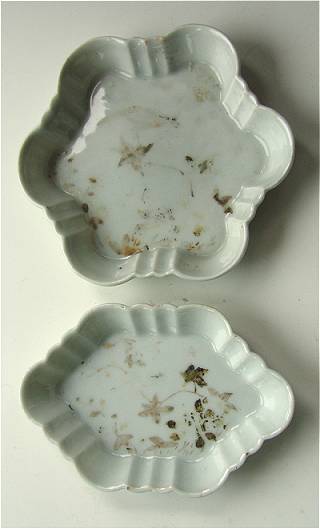
Top item: Tea pot stand with scalloped sides sometimes erroneously called pattypan. Bottom item: 'Boat' or 'Spoon tray'. Both from the East Indiaman Gotheborg cargo, lost in 1745.
Photo: Jan-Erik Nilsson, 2005.
A patty pan is technically speaking "a pan in which to bake patties". It is characterized by small size and low and scalloped sides, which is probably why these tea pot stands occasionally have been called patty pans. As a small tray shaped dish with scalloped sides, it was a standard part of Chinese export tea services during the first part of the 18th century. Most of those I have seen dates to around 1735-45.
Similar but more oblong matching dishes were also made as parts of tea services. Their name - or purpose - was to be spoon trays.
Since this was the formative years of the Western tea drinking tradition new shapes was invented and tried as they went. Some took off, some did not. Looking in the rear mirror of time I think we can safely say that these were two shapes that did not make it. As tea became more common and probably less expensive, the tea cups eventually got ears and grew larger. In Denmark some researchers (Annette Hoff, Den Danske Tehistorie, 2015) have pointed out that the drinking of tea was not only a social habit but also had the purpose of staying warm. Lack of firewood and the modest quality of the drinking water in a mostly flat agrarian country was also an issue.
Other small Chinese export porcelain bowls, low in height and with flat base and contoured rims do exists. that are also called patti pans. Maybe more correctly but, since a patty pan is a baking tin, I am not too sure about that.
A